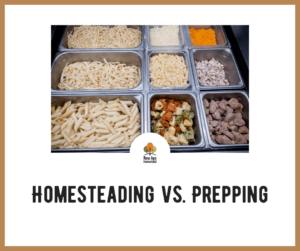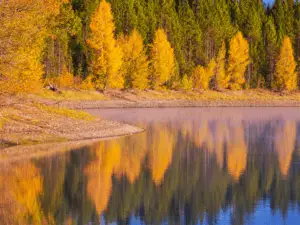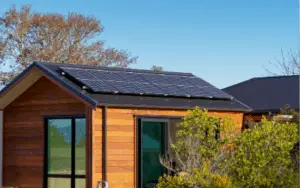There are a lot of different terms in the prepping, survival, and outdoor community that do not show up in everyday discussions.

Sometimes these terms are used interchangeably, which is incorrect.
This can make conversation confusing to newcomers as well as experienced individuals.
Two words I have been hearing used incorrectly lately are homesteading and prepping.
To gain a better understanding of these two labels I thought it would be helpful to cover some of the differences between homesteading and prepping.
To begin I will quickly define each of these words followed by more detailed examples of their differences.
Homesteading
A lifestyle where a person lives as self-sufficiently as possible.
This usually involves being disconnected from the power grid, utilities, and maintaining a renewable source of food and water.
In extreme examples, individuals may live close to the way that early North American settlers lived.
Prepping
A lifestyle in which a person stockpiles supplies such as water, food, medical supplies, and other tools to be prepared for emergencies or disastrous times.
7 Major Differences Between Homesteading & Prepping
Now that we have a simple understanding of these two terms, I am going to go into a little more detail about what sets them apart.
Location
Prepping primarily focuses on stockpiling supplies to be ready for natural disasters, interruptions in the supply chain, civil unrest, and pretty much anything else that has the potential for disrupting daily life.
As long as there is space available for the supplies, a prepper can live in a rural or urban environment.
Yes, a house or a house on a large property does provide more storage space over an apartment but prepping really can be accomplished anywhere.
Homesteading on the other hand requires land and access to natural resources.
Due to the very nature of a homestead, land is required for gardening, raising livestock, and possibly space to store equipment or a workshop to build what is needed.
This means that a homestead will likely be in a rural or remote location.
Now, there are urban homesteads in which people attempt to be more self-sufficient in their lifestyle and I applaud them for doing so.
But they may still be dependent on the power grid, and utilities. Urban homesteads are somewhat of a hybrid of the original term.
Food
Preppers may supplement their food supplies by hunting, fishing, or gardening.
But their food is primarily purchased at a grocery store and through companies that provide long-term survival food.
Homesteaders may buy some staples from a grocery store, but the bulk of their food comes from their property and surrounding land.
This is accomplished through hunting, fishing, gathering wild edibles, trapping, growing food, and raising livestock.
One of the goals of homesteading is to develop a relationship with the land and nature to obtain a healthier source of food while not being dependent on others.
From start to finish, a homesteader knows how their food is grown and what it has been exposed to. This puts the power of their food into their own hands.
General Supplies
Just like food, preppers buy the bulk of their supplies from a store or online business.
They may try their hand at a DIY project here and there but most of what they have is purchased.
Homesteaders will buy some items from a store but are more likely to make or build what they want or need.
Remember, homesteading is about being self-reliant and not dependent on others.
While making supplies could be a part of the lifestyle, it may also be a necessity depending on how remote the homestead property is.
For example, a homestead could be located a few miles outside of city limits or they could be hours from the nearest town or city.
Sometimes it is not an option to simply jump into the car and make a quick run to the store. So instead, a homestead will have the basics to build or repair an item.
Daily Life
Some preppers are hardcore, and they integrate aspects of prepping throughout their day.
But many preppers are passive in that they buy supplies, store them, and go about their life.
Prepping may just be one small aspect of their life or a hobby.
Homesteading requires dedication daily because there may be so much to do.
This can include building maintenance, property maintenance, tending to a garden or livestock, chopping wood, and many other tasks.
A true homestead is not a hobby or something that can be tucked away in a closet somewhere and forgotten about. It is there all day, every day.
Current Affairs
To be as prepared as possible, many preppers stay tuned into local, national, and worldwide news as much as possible.
People who choose to homestead do so, in part, due to its simplicity and disconnect from modern society.
That coupled with the physical labor involved means a homestead may not be as connected as the rest of us.
The Power Grid
Preppers maintain a modern lifestyle by staying connected to the power grid. They have appliances, computers, lights, heating, and air conditioning.
Preppers may have alternative power sources for emergencies, but they do not depend on them for everyday use.
Extreme homesteads may have no power at all, but it is more likely they will have electricity just in a limited amount and it is solely produced on their property.
Their power needs may be produced from a generator, solar panels, wind turbine, or a small hydroelectric generator.
Using Skillsets
Preppers like to acquire knowledge about being self-sufficient or as it pertains to survival situations. But those skills are usually used infrequently or practiced in ideal conditions.
The knowledge obtained by preppers is used more frequently by a homesteader simply because it is a part of the lifestyle.
A homesteader may use knowledge such as sourcing natural materials, land navigation, tracking animals, and coping with adverse weather conditions almost every day.
Wrap Up
As different as homesteading is from prepping, there is one common goal between them.
And that is the desire to not be dependent on others.
Preppers know that bad things can and do occur. And when that happens, they know they are the only ones solely responsible for the safety and wellbeing of themselves as well as their loved ones.
Homesteading takes a similar approach that applies to a broader range of topics. By having a renewable food source, water, and the ability to produce their own power, it is more difficult for a homestead to be “cut off” from the necessities of life.
I hope this article helped to better illustrate the differences between homesteading and prepping.
I am sure there will be some people who disagree with some of the comparisons I have made.
And that is okay.
Different perspectives give rise to conversations and that is how we learn from one another.
Thank you for reading and stay prepared or keep homesteading, the choice is yours!
Let us know what you think of this topic by sounding off in the comment section below.





